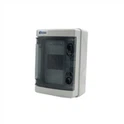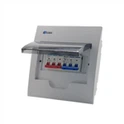Distribution Boxes: Types and Functions
The distribution box serves as the load centre and distributor of electrical power.
A distribution box ensures that electrical supply is distributed in the building, also known as a distribution board, panel board, breaker panel, or electric panel. It is the central electrical supply system of any building or property. As a component of an electrical system: it divides electrical power into subsidiary circuits and provides a protective fuse or circuit breaker for each circuit.
A distribution box houses all the contact breakers, earth leakage units, doorbells, and timers. The electrical power supply comes from the network to the building through the main feeding cable. The cable is connected to the distribution board and the power is distributed through the breakers in the secondary circuits (lights and plugs)
Components of a Distribution Box:
The basic structure and technical aspects of electrical distribution boards vary according to places and requirements. A typical electrical distribution box will include a bus bar, fuse links, switches, bypass equipment, and residual current detector (RSD.). At a broad level these components will aid in:
– Residential electrical installation
– The incoming supply circuit breaker or main switch
– Control and distribution board (consumer unit)
– Surge protective devices
– Earth resistance between the electrode and the point of zero potential.
Working with the wires and cables in an electrical system must be safe, and the distribution boards must ensure the following:
– The fuse should block overcurrent through the circuitry.
– There should be enough space for other wires, fixtures, and cables.
– Should not be prone to corrosion.
– Best quality wiring should be used to ensure safety.







